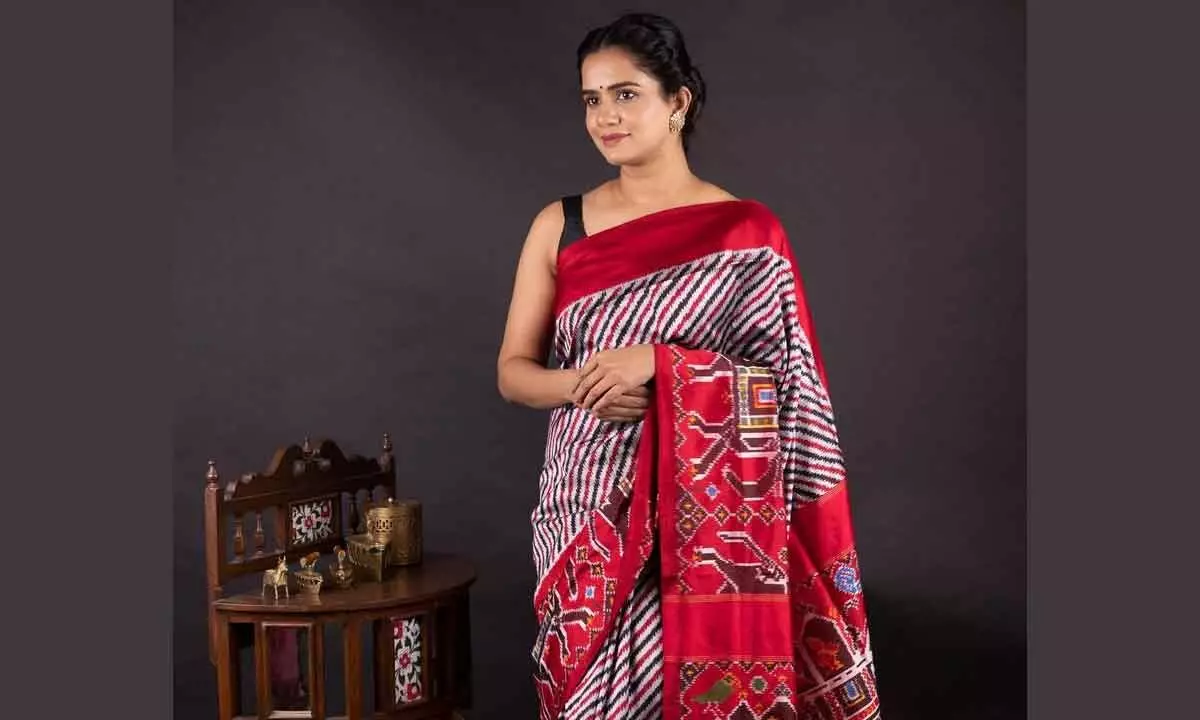Irresistible Ikat

Pause and imagine - a myriad of colours, dancing with contrasting patterns, bursting into bouts of bleeding joys and blurry lines.
Pause and imagine - a myriad of colours, dancing with contrasting patterns, bursting into bouts of bleeding joys and blurry lines. Indulge a bit further and ask yourself, if one could touch and feel that abstractness, wouldn't it feel wonderful? Open your eyes to the dreamy reality, popularly known as Ikat. Known as the 'poetry of the loom', Ikat grabs your eye, and heart and goes all the way to your soul. Synonymous to handlooms, Ikat exquisiteness has a history.
The unparalleled Ikat comes from two clusters in Telangana – Pochampally and - that are just an hour's drive away from each other – both unique in their designs, despite the proximity. Once upon a time, the town of Chirala used to be the centre of Ikat yarn-resist and this remote Telugu coastal town gained heavy popularity in both domestic and international markets. However, in the early 20th Century, the Chirala Ikat strangely lost its trade to the districts of Nalgonda, Medak and Mahbubnagar, for reasons still unknown. A plausible explanation could be that the craft caught the attention of the Nizams, who quickly patronised it and sported it mostly as dupattas with embroidery as embellishments; while few others even surmise that the proximity and accessibility made them go for the art.
Most historians claim for Ikat to have originated in Indonesia; however, its existence could be traced back to the Satavahana dynasty in India. To that effect, most of the evidence found today suggests that Ikat weaving began in the late 19th century, in the city of Chirala; and that the Pochampally and Puttapaka Ikat are relatively newer when compared to Patan Patola from Gujarat and Odisha Ikat. Today, Pochampally and Puttapaka weave Ikat in Telangana. While traditionally Pochampally Ikats were only made with cotton yarn, soon enough, silk sarees came into vogue as an effect of emerging trends. And in no time, it became the most exported amongst its peer group.
Ikat weaving requires meticulous handling by highly skilled weavers, for it has a madness to it (but there's a method). It starts with a design outlined on a graph paper. Subsequently, yarns are wrapped, according to the patterns laid out on the paper. This is then followed by the process of resist-dye where each yarn is then resisted according to pattern and colour, eventually unveiling the beautiful Ikat fabric.
An interesting fact finds its place at this juncture. In the early 20th century, two brothers from Chirala were trained in Gujarat and brought home the culture and craft of Patan Patola. Perhaps that explains why today, the Pochampally and Chirala areas specialise in creating imitation Patan Patola sarees.
From the seemingly simple to the unmistakably complex designs, the time it takes to weave is subjective. At the very least, it takes six days to weave a simple saree, and a complex design (using both warp and weft techniques) can take as long as even ten full months. That said, the need to check real Ikat arises today because even prints are passed on as real ones. So maybe a great place to start would be, by being a true connoisseur of it. Check the front and back of the saree– for a real Ikat saree is the same inside out and can be worn both ways too!
A saree that looks like a painting and feels like a dream.
One that weaves a pattern of grace and comfort. Born to dye, Only knows how to resist itself, Ikat is, forever. Simple by nature, Timeless by spirit. Steps of weaving Ikat
Step 1: Drawing designs on graph paper
Step 2: Drawing the designs on the yarn, depending on the type of Ikat technique.
If it has weft-Ikat, only those yarns are sketched and dyed (Single Ikat technique). In the case of a Double Ikat, both the weft and warp yarns are to be tie-dyed followed by intensely precise weaving.
Step 3: Multiple layers of wrapping cloth according to design and colours.
Step 4: Separate application of each colour. Higher the complexity and colours, the higher the tediousness!
Step 5: Unwrapping the tied yarn carefully, post the resist-dyeing; before weaving.
Step 6: Depending on weft or single Ikat (commonly used in Pochampally), true magic unfolds when the shuttle passes through and the design of Ikat takes birth.
Wardrobes and saree trunks are considered incomplete without original Ikat sarees, and they can never be full of too many either. So, when are you picking up your first or the next one?
(The writer is a handloom and handicraft enthusiast. She is also a member of crafts council. Instagram handle: Rajeswariramachander)














